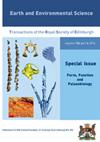Anterior ossicone variability in Decennatherium rex Ríos, et al. 2017 (Late Miocene, Iberian Peninsula)
IF 1.2
4区 地球科学
Q4 GEOSCIENCES, MULTIDISCIPLINARY
Earth and Environmental Science Transactions of the Royal Society of Edinburgh
Pub Date : 2022-10-19
DOI:10.1017/s1755691022000184
引用次数: 1
Abstract
The recovery of a new partial cranium of Decennatherium rex Ríos et al. 2017 bearing two anterior and two posterior ossicones from the Late Miocene deposits of the site Batallones-10 (MN-10, Cerro de los Batallones, Madrid Basin) sheds light on the complex variability of the cranial appendages of these extinct giraffids. The special features of the anterior ossicones of BAT10’18-C6-40, each formed by two bosses and separated by a septum increase the range of morphological variability found in the anterior ossicones of giraffids. Posterior ossicone variability has already been described in several sivatherine taxa as Sivatherium maurusium (Harris, 1974) but anterior ossicone variability has never been discussed for four-ossicone taxa. This new specimen accounts for the third morphotype found in D. rex anterior ossicones. BAT10’18-C6-40 is identified as an adult D. rex male on the basis of the development of the posterior ossicones. These are large and already show the first large bump which in this taxon is always located on the middle of the dorsal surface at a similar height on the right and left ossicones which agrees with Solounias (1988) who stated that these small irregular protuberances have a somewhat fixed position, suggesting a genetic basis. This new specimen represents a new example of cranial variability in D. rex, and makes it the extinct giraffid with the largest anterior ossicone variability found so far.Decennatherium rex的前骨骨变异Ríos,等。2017(晚中新世,伊比利亚半岛)
rex Ríos等人2017年从巴塔龙-10遗址(MN-10,Cerro de los Batallones,马德里盆地)的中新世晚期沉积物中发现了一个新的部分颅骨,其上有两个前部和两个后部骨化锥,这揭示了这些已灭绝长颈鹿颅骨附属物的复杂变异性。BAT10'18-C6-40的前听骨锥的特殊特征,每个由两个凸台形成,并由隔膜分隔,增加了长颈鹿前听骨的形态变异范围。在几个小骨化石分类群中,小骨化石的后部变异性已经被描述为毛小骨化石(Harris,1974),但四个小骨化石类群的前部小骨化石变异性从未被讨论过。这个新标本是霸王龙前骨化骨中发现的第三个形态类型。BAT10'18-C6-40在后骨化锥发育的基础上被鉴定为成年霸王龙雄性。这些突起很大,并且已经显示出第一个大突起,在这个分类单元中,它总是位于背表面的中间,在左右听骨锥上的高度相似,这与Solounias(1988)的观点一致,他指出这些不规则的小突起有一个固定的位置,这表明了遗传基础。这一新标本代表了霸王龙头骨变异性的一个新例子,使其成为迄今为止发现的前骨化锥变异性最大的已灭绝长颈鹿。
本文章由计算机程序翻译,如有差异,请以英文原文为准。
求助全文
约1分钟内获得全文
求助全文
来源期刊
CiteScore
2.00
自引率
0.00%
发文量
21
期刊介绍:
Earth and Environmental Science Transactions (formerly Transactions of the Royal Society of Edinburgh: Earth Sciences) is a general earth sciences journal publishing a comprehensive selection of substantial peer-reviewed research papers, reviews and short communications of international standard across the broad spectrum of the Earth and its surface environments. The journal prides itself on the quality of its graphics and photographic reproduction. The Editors are keen to encourage interdisciplinary papers and Transactions also publishes occasional special symposia and invited volumes of specific interest.
We are currently in the process of digitising the archive of RSE Publications, and the archive of the Transactions, dating back to 1788, will be available from the back issues link on this site.

 求助内容:
求助内容: 应助结果提醒方式:
应助结果提醒方式:


